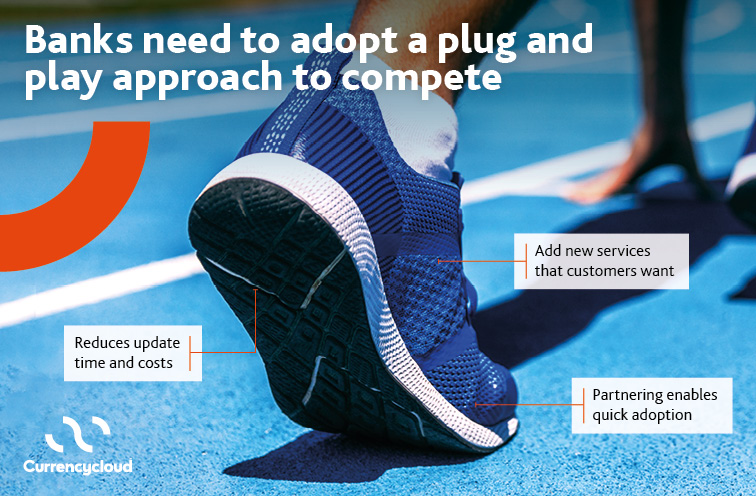The banking industry is going through some of the biggest changes seen in more than a century. Influenced primarily by customer demand and supported by technology and new regulation, traditional banks are facing some of the most testing times in their history.
Customers are used to, and are now demanding, personalized experiences and easy-to-use solutions across all aspects of their lives. The banking sector has been slow to embrace this trend but spurred on by regulation and the entrepreneurial spirit of start-ups like Monzo, Starling and Revolut, the rest of the industry is beginning to recognize the need to up their game.
Read more:
Open banking and PSD2 are two of the biggest influences on the changes we’re seeing in the financial services sector. These new regulations present an exciting opportunity for European banks to grow their existing customer base.
These initiatives have encouraged a proliferation of new financial institutions and Fintechs. Look at Yolt for example, an app that was built to allow consumers to see where they are spending their money and to collate all their bank accounts in one place – it empowers the consumer to have more control, one of the core intentions of opening banking.
According to a report from KPMG, investment in Fintechs hit $34.2 billion in 2018, with a total of 536 deals. The report goes on to say that: “In 2019, Europe is expected to see more consolidation within the Fintech space as winners set themselves apart from their competition. Consolidation will likely be driven both from Fintechs looking to buy in order to achieve greater scale and from traditional banks looking to buy in order to drive their own strategic objectives.”
How do European banks compete with this level of competition?
The squeezed middle
Big European banks like ING, RBS, Santander and Commerzbank have either launched new digital offshoots, indicated that they will do so in the future, or have transformed their services to provide a better mobile/online experience to customers.
At the other end of the spectrum are the neobanks and challengers that are nimbler, building from the ground up and not burdened with legacy issues and technology.
So how can the smaller banks compete? They don’t have the deep pockets of the former to establish new digital-first brands or the low technology overheads of the latter. Not to mention the issue of what to do with their legacy systems.
Analysis by Accenture shows that while banks allocate a higher proportion of their budgets to IT than any other sector (8.7%), more than 70% of those budgets are devoted to “traditional IT services (such as maintaining core legacy systems) and only about 30 percent on non-traditional solutions related to digital transformation, such as cloud or data analytics”.

Joe Paterson, Head of EMEA Banking, Currencycloud explains: “To compete in an increasingly fast-paced environment, these banks will need to integrate additional services to their core systems allowing a more plug and play approach to their services.”
Partnering with Fintechs such as Currencycloud to offer FX and cross-border payment solutions, or companies like IDnow for identity verification, Tink for bank account aggregation, or Passfort for compliance and monitoring of clients, enables banks to integrate new solutions and services without the major investments required when starting a brand new, digital-first bank.
Other options include working with software companies like Finastra and Temenos who have opened up their platforms to facilitate open banking, enabling banks to access Fintechs’ services.
New developments like FusionFabric provide a much-needed bridge that helps banks integrate services and launch new products faster.
Best in class processes
As well as enabling banks to keep up with modern technology, a platform banking approach makes it possible for them to adopt best in class processes. As a result, they can provide a wider range of services and products that customers want to use, building on the loyalty and personal relationships that they already have in place and reducing customer attrition.
Not only that, but responsibility for keeping these micro-services maintained and supported also lies with the developers, rather than with the bank that has integrated them with their core systems. This reduces the costs associated with updating and maintaining software.
A good example of this approach is the FX and cross-border payment solutions offered by Currencycloud, a transparent and compliant way of building out platform banking. If banks are looking to embed payments infrastructure into their existing platform or building a new product, this model provides a proven and easy way to deploy solutions for banks and their customers.
Its services could see banks winning back business in areas such as travel money (perhaps pre-loaded directly to debit cards) and offering lower-cost international payments that are received or paid using a local bank network to eliminate corresponding bank charges.
Traditional banks already have the customers, the accounts are open, the customer acquisition paid for and they are in the privileged position of being the customer’s primary bank. They are still ahead but will have to protect themselves by offering the same services as their challengers. Providing they do, those challengers are going to have some growth challenges of their own.
Find out how Currencycloud can help you address your challenges




